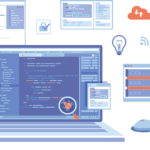In the early days of the Internet, customer experience was an afterthought. Websites were primarily static pages that displayed the same content regardless of who was viewing it, what they were looking for, or why they were on the site in the first place.
We’ve come to expect much more from modern websites.
Businesses now customize the modern web experience to suit the user. The Internet is an ecosystem of information curated to viewers’ tastes, automatically tailored recommendations, and immense personalization.
Traditional websites were primarily designed with content management in mind. Modern websites must also manage all of a business’s customers and data.
This increasingly customer-centric focus necessitates a new approach to how organizations put websites together. It requires customer relationship management.
How Customer Relationship Management Creates Better Websites
Websites integrate customer relationship management (CRM) tools as foundational elements of their services to collect, organize, and use customer information.
CRM tools provide businesses with a simple way to store their customer data at their most basic level, such as contact information and purchase history. This data is essential for companies to communicate with their customers effectively.
Businesses rely on CRMs to track and coordinate customer communications across various channels, including phone, email, social media, and support tickets. This way, businesses can quickly reference everything they need to know about a customer from a single interface. But rather than acting as a simple static repository of customer information, modern CRMs also help generate the customer experience.
A CRM-powered website centralizes customer data as a foundational element of the back-end. As a result, organizations can automatically customize presentations on the front end based on what they know about their customers.
Such data helps personalize automated communications. For example, companies can target and customize email campaigns and responses based on customer behavior, purchase history, and other details.
At a higher level, CRMs automate a variety of marketing tasks. They can track customer interests, automatically assign customers to specific marketing campaigns, and customize calls to action, images, and offers.
A CRM-powered website leverages these capabilities to change elements of the website itself. It can direct users to specific landing pages, alter graphics, change text, display or exclude content, and customize the entire website’s presentation to fit into the customer journey context. It’s dynamic and automatic.
Customers Come First
Traditionally, a content management system (CMS) forms a website’s basis. The CMS handles publishing and managing the website’s content, like pages, blog posts, and media files.
Most businesses aren’t satisfied with simply presenting their content, though. They also need interactive elements that enable users to make purchases, book appointments, or request information.
The average website leverages various tools that work in conjunction with its CMS to accomplish these tasks. For example, an eCommerce site might rely on:
- A CMS to publish and manage content
- An e-commerce system to handle inventory and sales
- A newsletter system to communicate with customers
- A customer service ticketing system to handle problems and inquiries
While such a toolset does work, it rapidly introduces several management problems.
Primarily, disparate tools collect all the customer data. Instead of centralizing all this data in a single source, essential customer details spread across various interfaces. It’s challenging for employees and automated systems to use this vital customer data.
A CRM-powered website replaces the old content-first model with a much more practical customer-first philosophy. Instead of building our website on a CMS coordinating the site’s content, we generate our entire website from the ground up with the customer in mind.
Customer data becomes the integral element that informs everything a CRM-powered website does. By making customer information our website’s base layer, we can effortlessly collect and update customer data, rapidly analyze that data from a single interface, and automatically personalize our website for every visitor.
Building a CRM-Powered Website
How does a website become CRM-powered? There are three primary ways to integrate CRM features into your website:
- Custom solution: Your website can interface with an existing CRM system through your code (for example, leveraging the HubSpot API), or you can purpose-build a from-scratch CRM solution.
- CMS plugin:Modern CMS platforms readily integrate with various CRM tools via plugins, such as the HubSpot WordPress Plugin. These plugins provide access to CRM tools with minimal setup but can’t offer some of the advanced features a truly CRM-powered website provides.
- End-to-end CRM integration:Services such as HubSpot’s CMS Hub take the CRM-powered website philosophy to heart. CMS Hub uses Hubspot’s CRM as the foundational element of the service. It equips you with an ever-expanding arsenal of native tools to craft unique user experiences based on customer data.
Real-World Results
An exemplary case of a business making the transition from a traditional CMS-powered to a modern CRM-powered website is Bitext.
Despite its early success, Bitext had a limited emphasis on marketing. Bitext relied on a standard WordPress CMS, which did a good job at hosting their content, but told them little about their customers.
Leveraging HubSpot’s personas to understand their customers better, Bitext created a series of workflows to automatically enroll customers in relevant campaigns, customizing their user experience to suit the digital marketing strategist’s specific goals.
Opting for an end-to-end integration, Bitext transitioned their old WordPress site over to the HubSpot CMS Hub. This approach enables them to track every interaction a customer has with the site in rich detail, giving Bitext’s marketing team invaluable data to improve their customer experience further.
Bitext ultimately increased web traffic by 7x and leads by 10x.
While many factors undoubtedly contributed to Bitext’s success, this dramatic transformation began with their decision to move to a CRM-powered website.
A Customer-Focused Future
One thing is clear: the emphasis on customer experience grows stronger every day.
Without insight into the people behind the purchases, websites are stuck in the old mold of one-size-fits-all solutions.
In the past, only billion-dollar businesses could collect rich customer data and automatically customize the user experience. Now, technologies like HubSpot empower any business owner to put advanced CRM capabilities to work.
At the core of any CRM-powered website is a customer-focused philosophy. Perhaps more important than the ability to customize your website based on customer information is the simple idea that you should tailor your user experience customer-by-customer.
If you haven’t already, consider how leveraging a CRM improves your website, business, and, most importantly, your customer experience. Start experimenting with a CRM today.
If you’re interested in developing expert technical content that performs, let’s have a conversation today.




